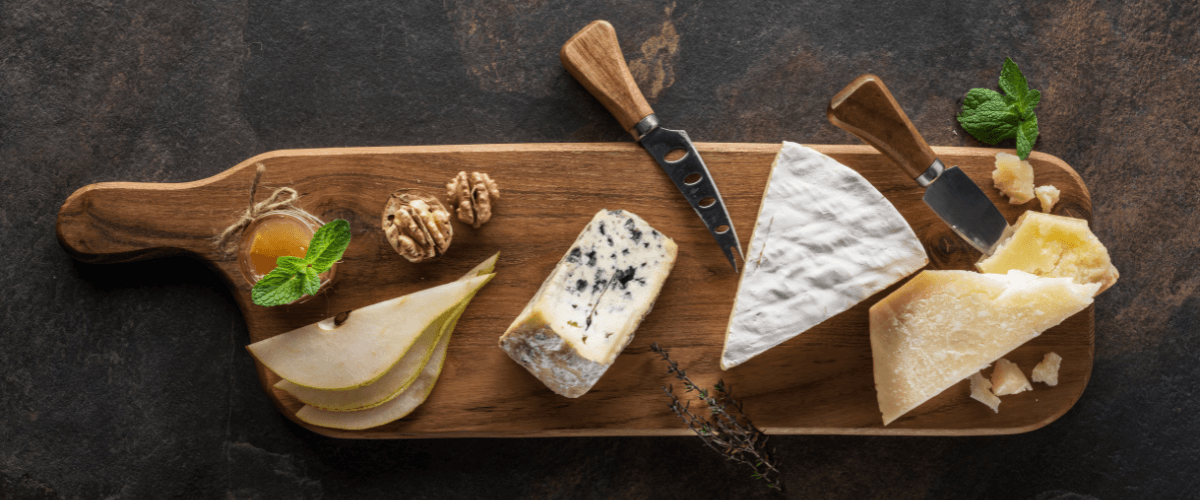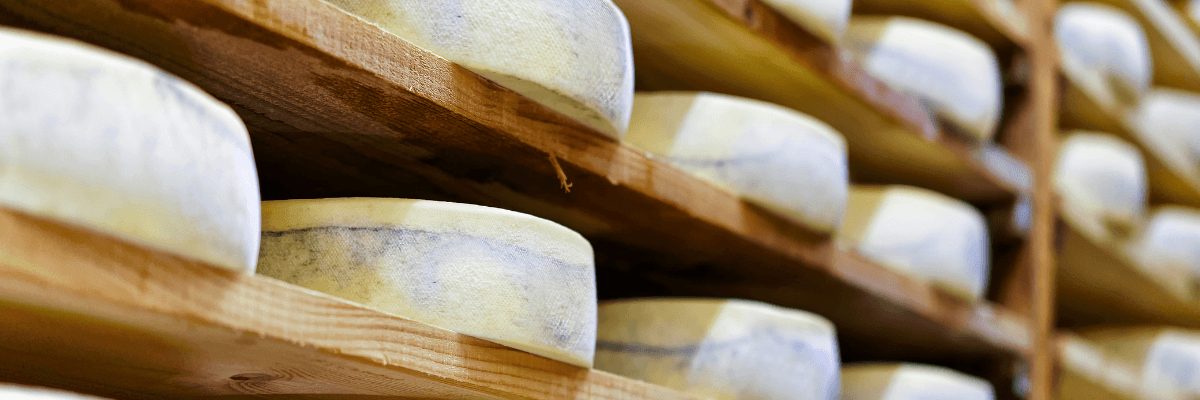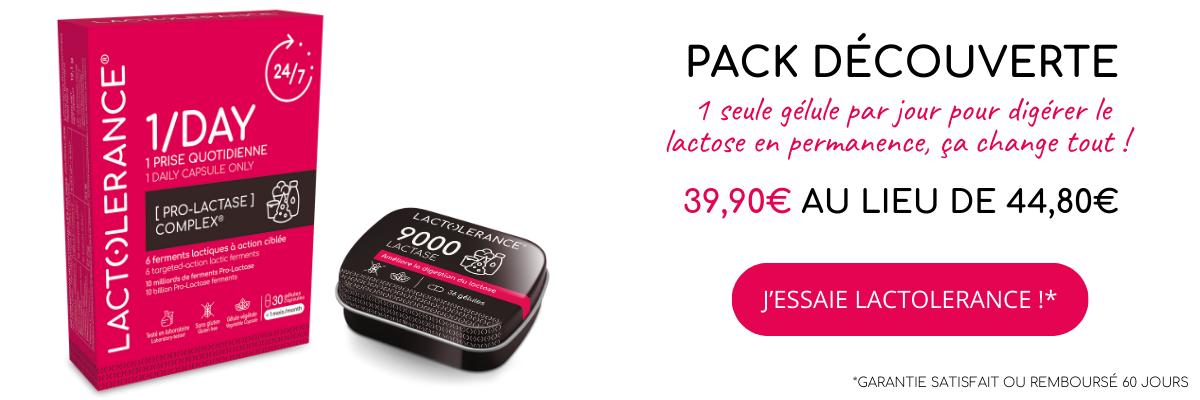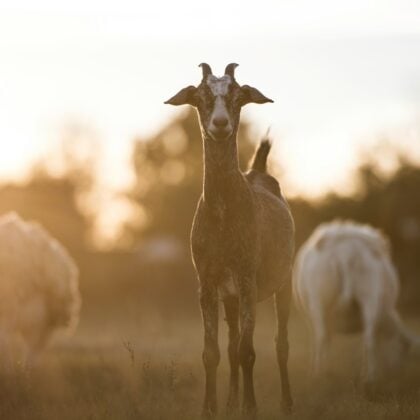
Lactose-free cheese: an impossible equation? 🧀
Aaaah cheese 😋! That savoury pleasure between the main course and the dessert that is the envy of the world (Cocorico 🇫🇷). For people suffering from lactose intolerance, this food is a real source of anxiety! But did you know that you can eat them without fear of unpleasant symptoms?
In this article, you'll discover :
👉 Cheeses you can eat without risk
👉 Cheeses to avoid if you are intolerant to them
👉 Plant-based alternatives
👉 Our advice on choosing the right cheeses
👉 The foolproof way to eat ALL the cheese you want
Get ready and get out your breadsticks! 🥖
(Almost) lactose-free cheeses 👍
Let's unravel the treasures of the cheese world adapted to your intolerance. 🔍
Aged cheeses such as cheddar, parmesan and gruyère are often well tolerated by people with lactose intolerance. This is due to the maturing process, which significantly reduces the lactose content.
From curdling to maturing: how will lactose (almost) disappear from your cheese?
To better understand this phenomenon, here's a short lesson on the cheese-making process.

Stage 1 - Curdling (or coagulation)
This stage consists of inoculating the milk (with lactic ferments or rennet) in order to solidify the milk proteins. curd (the dry matter that will be used to create the future cheese) and separate it from the whey (or whey, a liquid composed mainly of water and milk). milk sugar, i.e. lactose) !
Stage 2 - Draining, salting, moulding and pressing
The curd, separated from its whey, will now undergo several successive processes to become cheese (draining, salting, moulding and pressing) which will further reduce its water and lactose content.
Stage 3 - Refining
The cheese is then placed in a maturing cellar for a period of varying length (from a few weeks to several years) to encourage the development of flavours. It is during this period that the rind of the cheese (hard paste) will form under the action of enzymes (natural bacteria) that will feed on the proteins, lipids, etc. that are present in the cheese. and lactose remaining in the milk.
🌟 Therefore, the more mature a cheese is, the less lactose it contains! (Golden rule) 🌟
Fans of hard cheeses can therefore enjoy their meal without fear of digestive problems, as the lactose content is residual. It all depends on your tolerance threshold, but it really does take excessive consumption to develop symptoms.
Here are a few cheeses you can enjoy with complete peace of mind:
Comté, Gruyère, Emmental, Gouda, Parmesan, Mimolette, Cheddar, Reblochon, Raclette, Morbier, Beaufort, Abondance...
Keep a close eye on Mozzarella and Burrata cheeses !
Cheeses to avoid ⛔
Fresh cheeses don't undergo as much processing during production (the adventure stops before draining), so they contain much more lactose! You should also be wary of industrial cheeses and "slimming" cheeses. To guide you, here are some examples of cheeses to avoid in each category.
Fresh cheese
Faisselle, Fromage blanc, Mascarpone, Ricotta, Petit-Suisse, Saint Môret, Philadelphia, Carré Frais, Boursin, Tartare, Chavroux, Fromage fouetté...
Industrial cheeses
Vache Qui Rit, Kiri, Petit-Louis, Apéricubes, Kidiboo, Cheddar Burger...
Light / slimming cheeses
Saint Môret Light, Philadelphia Light
For soft cheesesThe precautionary principle therefore applies! It will depend on your level of intolerance and how long the product has been maturing, variables that are difficult to control... So the precautionary principle applies! Read labels carefully and opt for small portions.
Here are some examples of soft cheeses:
Brie, Neuchâtel, Brillat-Savarin, Caprice des Dieux, Chaource, Camembert, Mont d'Or, Curé nantais and Epoisses.
Plant-based alternatives 🌿
You've probably heard of vromages "or fauxmages " ?
These alternatives are 100% plant-based and therefore lactose-free. perfect for those who have adopted a strict diet or opted for a vegan/vegetarian lifestyle. Made from ingredients such as almond milk, soya milk and cashew nuts, these vegan cheeses offer a wide range of flavours and textures for your recipes.
Whether you're looking for a melting cheese for your pizzas or a spreadable cheese for your toast or sandwiches, plant-based cheeses are a must-have in your kitchen.
But be careful about what they contain, some recipes may be high in FODMAPs and therefore expose you to other intolerances.
The Violife and Nurishh brands are a safe bet.
How do you choose your cheese? Our advice!🤔
Eat real cheese
You now know everything there is to know about the manufacturing process for a natural cheese ! The length of the maturing process and the almost total disappearance of lactose will be your best ally in the face of your intolerance. Choose farmhouse products made from simple ingredients. Avoid industrial cheeses (artificial cheeses, synthetic cheeses, spreads, grated cheese or other "cheese preparations") which contain numerous additives and whose composition may reveal unpleasant surprises (other FODMAPs).
Your taste buds and digestive system will thank you!
Read labels carefully
A cheese you can trust is usually printed on the label:
- The name of its variety/appellation (e.g. Comté, Cheddar, Camembert, etc.)
- A limited number of ingredients, proof of its natural origin (no additives or colourings)
- The requirement to keep it in a cool place (unlike artificial cheeses containing preservatives)
- (Almost) zero carbohydrate content (i.e. lactose, the milk sugar).
What if you ate ALL cheeses WITHOUT COMPROMISE with LACTOLERANCE?
The foolproof method: lactase supplementation 💊
For over 10 years, the French laboratory Physiosynthèse has been offering a range of food supplements to help people with lactose intolerance to digest lactose without problems. A small amount of lactose hidden in certain foods (cold meats with a cheese platter, for example) can cause lactose intolerant people to suffer from uncomfortable symptoms (bloating, gas). These symptoms can even become very disabling (diarrhoea, pain) when you least expect it!
We have the solutions:
- LACTOLERANCE 9000 Concentrated lactase for severe intolerances. 1-hour protection. Taken on demand.
- LACTOLERANCE ULTRA Concentrated lactase for severe intolerances and digestion of fatty foods. 1-hour protection. Taken on demand.
- LACTOLERANCE 1/DAY a probiotic-based formula that protects you for 24 hours against all symptoms one capsule a day whatever your level of lactose intolerance!
This approach allows you to live out your passion for cheese without sacrificing pleasure or digestive comfort.
⬇️ You'll be able to go out to restaurants and enjoy delicious, convivial moments with friends and family. ⬇️

Opt for an unlimited cheese experience with LACTOLERANCE!

Hello, I'm Vincent
Like you, I'm lactose intolerantI know exactly what you're going through and the difficulties you encounter on a daily basis. For over 10 years, I've been helping our customers to use our dietary supplements and giving advice and tips on how to improve their digestive comfort. I'm also a keen cook and gourmet, so you'll find my favourite recipes for a lactose-free diet in this blog.
Lactose intolerance is not inevitable! With LACTOLERANCE you can digest with complete peace of mind






